Results for ‘MEMORIES’
[Tribune, 25 May 1979]
Welland had the unique distinction of having the first woman in Ontario to receive a Bachelor of Arts degree.
Miss May B. Bald born in Welland, attended public school here and received her graduation diploma form Welland High School in 1878.She later attended the University of Toronto where she obtained her BA degree.
Returning to Welland she taught at the high school, and eventually went to New York where she lectured at Columbia University. She travelled extensively for a woman in those days and later taught at a girls’ private college in New York.
From time to time she visited in Welland with a cousin, James C. Bald and family who lived on the original Bald farm. May Bald died in New York City and was buried there around 1937.
90-year-old Wellander recalls years at WHS
By Eileen Zarafonitis
[Welland Tribune, 25 May 1979]
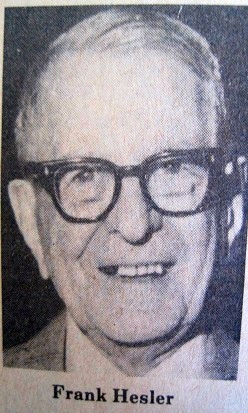 At 90 years of age Frank Hesler still vividly recalls the years spent at Welland High.
At 90 years of age Frank Hesler still vividly recalls the years spent at Welland High.
It was shortly after the turn of the century in 1903 when Frank Hesler transferred from St. Peter’s German Lutheran school in Humberstone to pursue a secondary school education at Welland High.
Commuting to and from school by train, Mr. Helser remembers, “It used to cost me $2.30 a month for 23 return rides. The train left at 8:15 in the morning, and was supposed to leave Welland at 4:15 in the afternoon, but it was never on time.” At that time he was the only boy attending the school from Humberstone.
Reminiscing about his schooldays and principal H.M. McCuaig, he said, “I remember him well. His father was a Presbyterian minister in Welland. Not only was Mr. McCuaig a good principal he was a darned good Latin teacher, but I never found out how he handled discipline because I was never called up on the carpet.”
FOUR ROOMS
In those days the school consisted of four classrooms with seats. “There were five forms so we had a lot of study sessions while lessons were going on. There were also only four teachers, then, but as I remember, there were only about five students in the fifth form.” Mr. McNeice was the math teacher. “I got along well with him.” Could be that respected math teacher was instrumental in Mr. Hesler’s decision to pursue a career in accounting.
Literature was taught by Miss Clara Buchner whose brother had taught Mr. Hesler at public school. Speaking on the various subjects of the day he recalled, “You had to take Latin and one other language, but for reason nobody took Greek,” he laughed. The only library was located in the principal’s office.
“There was no phys ed in my days. Everybody threw in a dime or quarter for a pair of boxing gloves. In the warmer weather we’d do some jumping and kick a ball around outside.”
He remembers the confusion over the names of his classmates Ross Gordon and Gordon Ross. Then there were the Corcoran brothers from Port Robinson and the Stanley boys from Port Colborne. Some of them died in W.W. 1. The doctor never told me why I wasn’t accepted. I was 90 when I found out I have only one kidney. If I’d known then I probably would have died from worry.
Mr. Hesler went on to lead a distinguished career which included 19 years on the Board of Education. “When I went on the board which was all volunteer work then, things were moving up. I was on council in 1928 when we got the OK to build a new vocational school. I was appointed to the vocational committee and was responsible for the typewriting and bookkeeping department.”
By the 1930s, Marguerite, Bill and Dick Hesler had followed in their father’s footsteps and were attending what had become the Welland High and Vocational School. As a school board member “I always disagreed with the rule that said children of staff or boards members couldn’t receive any school awards. Anyway after the rule was changed my son Dick and Guy Johnson’s son both won awards. Guy Johnson was the school principal at the time.”
Even though 76 years have passed since Frank Hesler first walked the halls of Welland High, the memories remain alive. And yes, he and his wife Emily will return for the anniversary celebrations if his health permits.
19 August 1904-10 May 1988
It is Easter Morning, wonderful day of hope and assurance for all people. As the sun is slowly rising in the east, our family is stirring, Father, Mother, my younger sister and baby brother. Someone, likely Mother, softly singing, “Low in the grave He lays, Jesus my Saviour, Waiting the coming day. Jesus my Lord.”
We all join in, even baby brother. Father who cannot sing alone except when rocking the baby, then he has a quaint little lullaby all his own.
I hear Father open the door of the big airtight heater and with the poker stir the coals, likely a large elm knot fitted in the night before or possibly maple or beech, and with a small fire shovel he takes coals to the kitchen stove while colored sparks fly, he lays on the kindling prepared the night before.
By now the crackling of the fire has created a warm cozy atmosphere and whetted appetites.
We thank God for the food. Mother brings a steaming plate of pancakes and with liverwurst or perhaps bacon and eggs, all produced and processed on the farm. Soon the Bible is read and we have family worship with everyone kneeling in prayer. I go to the barn with Father to feed the stock, milk the cows, separate the milk and feed the calves, hogs and chickens.
Before Church we children eagerly search for small berry baskets lined with soft green moss gathered the day before on and beneath a nearby rail fence.
The boxes are covered with bright colored paper and tied with ribbon. They usually contained two eggs which had been wrapped in onion skins and boiled which gave a soft brown color, also small candy eggs of the jelly bean variety.
We hitch the team and start for the nearby Dunkard Church, later the brethren in Christ. We ride in a two seated democrat wagon with covered top and side curtains.
As we enter, the children go to a room for Sunday School, then to the sanctuary where the men sit on the right, the women on the left.
There is a raised platform at front used as a mourner’s bench where the very young and sometimes very old, bow to make their peace with God during the Revival Meeting.
On the platform is the long pulpit or desk and back of it the bench for the ministers, usually two or three in number.
One minister lines the song and calls for someone to raise the tune, today it will be “Christ Arose,” and likely the inspiring Coronation Hymn of the Church, “All Hail the Power of Jesus’ Name.”
The second minister reads one of the profound resurrection scriptures followed by a sermon of one hour and all experience edification of spirit thereby.
On Easter Sunday we go to Grandpa Shafers for dinner. No one could cook like Grandma or my Mother, as they are Pennsylvania Dutch, so on this day there is a large platter of fried eggs, roast chicken, dressing, mashed potatoes and all that goes with a German Easter Dinner. Very appealing to an eight year old boy.
Grandpa asks the blessing sometimes in German. In our home the musical instruments consisted of Mother’s accordion and the children’ mouth organ. And, oh we loved to sing!!!
At Grandpa’s there is Uncle John, Mother’s younger brother, who had that marvelous invention, the gramophone with “His Master’s Voice.” Trademark, a cute little dog with turned head peering into the purple horn as he hears his Master’s voice.
Shy, likeable Uncle John, one of a kind, born in a sod house in Nebraska. When Grandpa took his family from Pennsylvania, he lived in Iowa, Kansas and Nebraska and while some settlers became wealthy, the locust, hail, prairie fires and drought drove them from State to State and to Canada in 1900 to farm. They first lost their cattle in a T.B. test and their barn by fire, but with a strong faith in God, they never quit.
Uncle John never married, and at seventy years of age sat on his bed and died with heart failure.
Part of his estate built a fine Medical Clinic at the Montreal Lake Indian Children’s Home, housing sixty-four native children, Timber Bay Indian Reserve, Sask.
Again we hear the appropriate “Christ Arose” and others pertaining to the resurrection and our hearts are lifted in Praise to God for his unspeakable gift to mankind.
At home, Mother would sing the beautiful “America” never “The Star Spangled Banner” and she taught us in German “Stille Nacht Meilige Nacht” and Gott ist die Leibe.”
The sun is sinking in the west and we return home and the chores of the morning are repeated. As we snuggle down in our warm feather beds, we thank God for our parents, family love, our home and that “THE LORD IS RISEN INDEED.” Luke 24:34
[August, 2017]
I was born in the Welland Hospital and have two sisters, Elaine and Brenda, and a brother Fred. We lived on Deere St. with our parents Lorraine (from Saskatchewan) and Andrew (born in Detroit). Andrew worked at the Page Hersey as a welder for almost 40 years. My grandfather George lived on Harriet street after his rum-running days were over in Windsor/Detroit area. My father’s sister, Rose, told me about the gypsies which used to pass through Welland occasionally. When she got up early on the farm, just west of Eastdale high, to do her chores, now and then off things would occur. The eggs were gone and the cows had already been milked. She said the neighbors also had the same problem. Then someone spotted a gypsy encampment outside of town. The men got on their horses and rousted the camp, running the gypsies far out of town. My father’s brother, George, owned the grocery store next to the Tastee Freez on Ontario Road. They moved away to Stratford.
I learned to swim at the Memorial Park pool and then moved on to the old canal and the rock quarries and beaches around Port Colborne. I remember almost drowning at Nickel Beach and also the big flour mill fire out near the Pt Colborne pier
My elementary school was the now non-existent St Peter and Paul school. Some nuns could be very strict and mean but there was a piano in every room and they taught us to sing every day. We also used to clean the school yard of litter a few times a year. The school boundaries would change often so I went to Centennial Secondary, Eastdale, Welland High School and a stint at Niagara College.
As teens, my pals and I would chase girls down at Long Beach and Niagara Falls. The drinking age in Ontario was 21 so we’d all pile in cars and go ‘over the river’ to Buffalo. where the age was 18. Bars there were a lot of fun, much looser than the uptight Ontario. I worked at Dominion and A&P stores in Welland, Niagara Falls and Dunnville.
I left town for traveling in 1973, returning in 1975 for a few months and worked at Stelco in Hamilton before leaving again for good.
In my middle grade books on Welland, I string together real characters and incidents Wellanders can enjoy too. The stories bring back memories and their kids seem to be interested in what life was like back then, too.
by PHYLLIS HILL
13 September 1989
The Green School was built in 1921 as a temporary school at the corner of Thorold Road and Willson Road on railway property.
Due to the heavy industrialization of Welland, the Brick School on Fitch Street also known as the Red School or Stop 20 School had become overcrowded.
The Green School served Grades 1 to 4 and the Brick School became the Senior School for Grades 5 to 8.
The one-roomed Green School was simple furnished with a piano, desks and benches, blackboards, the teacher’s desk, a potbellied stove, boys and girls cloak rooms and out back two seater outhouses. The warm days the teacher taught lessons in the shade of a nearby orchard. This school was in use until 1948 when a new school was built-namely J.C. Bald.
The Green School was used by the Anglican Church for Bible classes as early as the 1920s’ and occasionally throughout the years. On February 16th, 1947, the first session of St. David’s Church School began in the little Green Schoolhouse.
This school later became a Community Centre and at that time St. David’s Church began holding more regular services which led to the building of St. David’s Church. The school was later moved to Fitch Street in 1953 and became a private residence.
All that remains are fond childhood memories and grateful parishioners at St. David’s Anglican Church.
| Black and white drawing of the Fox Family Home, Welland, built in 1951 by Stewart Construction was a commission completed by Renfrew artist, John Robert Bradley. |
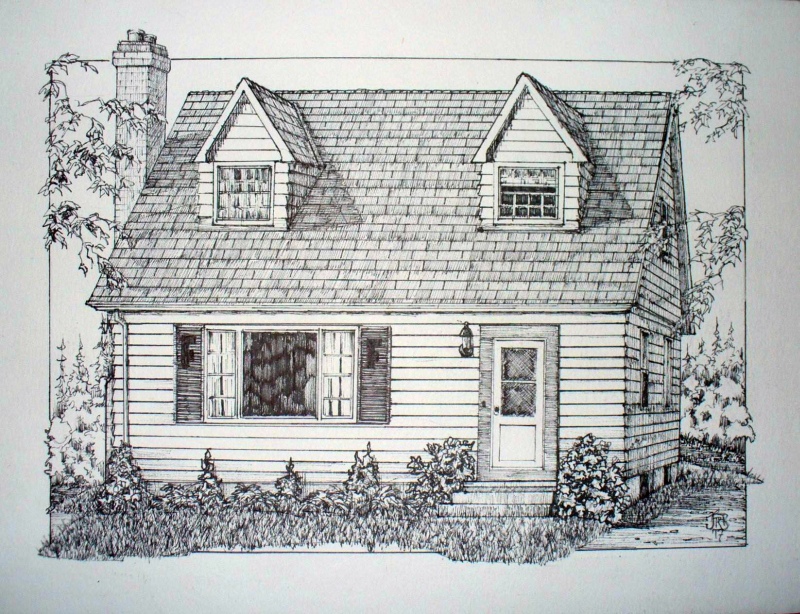 |
My first years were spent in Northern Ontario, so I grew up with an affinity for Nature and the wonders of what lay hidden in the woods. I appreciated it even more after a move to Niagara Falls and the beginning of school life. There I found my favourite subject was always art. As a young boy, growing up the eldest in a family of six I entertained myself and others with cartoons and caricatures of friends and family, creating my own storyboards and comic “strips”. As a teen, I learned to draw the figure by copying my comic book heroes and when I got to High School I was able to benefit from some skilled teachers. There, I was encourages to experiment with various media including the newly introduced acrylic medium. I was able to try landscapes for the first time. It took me back to my days in the North and the way I saw the wonderful world of Nature.
A life in retail after high school took me away from my art although my creativity never wavered. It was always there, just inside waiting for a chance to come out on a permanent basis. It was after a spiritually transforming experience in the spring of 1998 that I was given the chance to return to school to study art….so being in Toronto at the time I was accepted into the Fine Arts program at the Ontario College of Art and Design. At O.C.A.D., I benefited from the attentions of some of Canada’s most accomplished artists and the tremendous talents of fellow students. I took courses elsewhere when I could, and was particularly interested in the art derived from dreams and the aboriginal art in Canada and elsewhere in the world. A very special and close friend had a cottage and it was there that I felt the call to pick up the brush of landscapes once again. It was a joy to my heart that had been missing for many years. I also learned to honour the teachings I was receiving in my dreams which came each night in full colour and remained fixed in my mind until I had carefully sketched the details and recorded the colours I was seeing.
After graduating with honours with a diploma in fine arts and a major in drawing and painting I did a few shows but a return to the world of retail again cut into my creativity. I did manage to develop and teach a course in dreams and symbology at the Ottawa School of Art in the fall of 2004 and that convinced me to pursue that at some time in the future. Painting and teaching have finally become a passion and I have structured my working life around that instead of the other way around. This has led to much satisfaction in myself as an artist and teacher, and also as a person. I look forward very much too where Spirit will now take me on this journey.
John does commissions and would happily consider your request to reproduce a special building for you.
Contact # for John is jrbradley1953@hotmail.ca
by Al Garner
When I was a teenager (17-18 years old) growing up in Welland in the mid to late 1950’s, one of the social events that helped pass the time was occasionally crashing weddings on Saturday nights at one the many ethnic halls in the city. For example there was the Hungarian Hall, Italian Hall, Polish Hall and the Ukrainian Hall.
Our modus operandi was as follows. We’d check out the Welland Tribune newspaper to see what was going on at a particular hall on the upcoming Saturday night. We’d dress up in our best clothes either a suit or sports jacket, white shirt and tie and of course shined dress shoes. We’d hit the hall of choice after the wedding guests had eaten their dinner, usually about 8:30pm-9:00pm. By that time everyone was well oiled from the booze and food and no one would pay attention to us. We’d saunter in usually one or two at time. We’d work our way up to the bar, order free drinks, usually beer or rye whiskey and munch on the food that was left over from dinner. At the Hungarian Hall, which was my favorite, there would always be paprika chicken or cabbage rolls and perogies to chow down on.
We’d hang out at the wedding for a couple of hours, have a few drinks, dance the polka or chardosh with the good looking girls, get half pissed and then jump in our cars and head over to Niagara Falls, New York and go drinking and dancing until the bars closed at 4am.
Now keep in mind this didn’t happen every Saturday night but when we got bored or were low on money, which for me was most of the time, it was a fun way to get free drinks and have a good time.
By Allan Garner
Myrtle Avenue – Main Street
In those days Welland was the armpit of Southern Ontario. Some would say it still is. There were many industries such as foundries, forge shops, textile mills and the bigger factories such as the Atlas Steel, the Electric Metals (Union Carbide), Page Hersey Pipe Mill and of course the Wabasso Cotton and Dominion Textiles.
These great industrial giants surrounded our blue-collar neighbourhood. As mentioned the Atlas Steels was the biggest and employed almost a thousand men during World War ll. We lived at 27 Myrtle Avenue with my Grandma and Grandpa Garner. The Canada Foundries and Forgings employed my Dad’s family. For example Grandpa Garner and his brother, Uncle Fred Garner started at the plant around 1918 or so. By the time they retired, they had logged about 90 years at Canada Forge between the two of them.
The factory was right at the end of the block at the corner of Myrtle Ave. and Major St. East. It was a two-minute walk for Dad and Grandpa to go to work in the morning.
The Atlas Steels Recreation Club was the predecessor to the modern day recreational facility. They had a bowling alley, and a projector and screen set up where they would show Hopalong Cassidy movies with William Boyd as “Hoppy” and Andy Clyde as his side kick. There were also cartoons and free donuts and chocolate milk. The rules were that it was for employee family members only, but I always managed to scam my way in. Thanks to the Brettell boys. Even at the tender age of seven or eight I figured out how to get in through the pass gate.
Winters
I remember the very, very cold winters of Welland. Jesus it was cold in the winter. Snow up to here, the cold crunch of your boots on the snow. Walking out to “The Pond” to play ice hockey. We would pack our lunches and walk out to The Pond. It was about a mile and a half walk from our house on Myrtle Ave. Maybe it wasn’t that far but it seemed that far when I was a kid.
We’d strap on the blades, play shinny all day long till almost dark. It seemed like ten miles on the way back. I’d skate back home on my very fragile ankles, tears in my eyes, exhausted but happy to be part of the gang.
WWII
The world from my eyes, those of a five year old was all black and white. I remember in those days that almost every movie that you went to was in black and white. There just wasn’t much colour. An event that sticks in my mind, even to this day are the blackout curtains and the air raid sirens going off. We had to practice for the dreaded German invasion of course! Because the Germans were about 4,000 miles from us! Welland in those days was a major supplier of war materials so we had to be very careful and aware of the consequences of the dreaded Nazi Blitz Kreig attacks. But there was hope, generally it was ok. And eventually we won the War!!!
One of the things that I remember as a kid was going to Plymouth Cordage Park in Welland after the Allies won WWII. It was a huge gathering of people, perhaps some 3000-4000. Effigies of Hitler, Tojo and Mussolini were burned as the bands played and people cheered. The war was over and we won.
Another post war memory is that the city had a parade for the returning vets. I remember walking down Main Street just about where the liquor store was in between River Road and Hellems Avenue with my uncle Willard proudly holding his hand at this victory celebration parade. The war was over. Uncle Willard was home from the war. He was my hero. Willard was captured at Dieppe and was a POW for some 31 months. He was released from a German prisoner of war camp, a hero. I don’t think he considered himself a hero though. He probably considered himself an unlucky SOB to get captured at Dieppe and held captive in a German POW camp for almost three years.
I often wonder how my Dad felt about Willard. My Dad you see was drafted to go into the army. Family and friends had a big party for him. He was on his way to war. He was on his way to Hamilton to get sworn in. At the last moment a phone call came and he was told that because he was the last surviving son in Canada he didn’t have to go to war. I often wondered if he was happy or disappointed. Probably a little of both because the war was such a big thing in those days.
Welland Canal
To write about Welland and not mention the old Welland Canal is almost sacrilegious. The Canal as it was rightfully called in those days ran right through the centre of town. It joined Lake Ontario to the North and Lake Erie to the South. The Canal was, and still is an integral part of building the trade routes between the United States and Canada via the Great Lakes.
The canal in those days separated the executive families who lived on the northwest side of Welland from the blue-collar worker’s families that lived on the southeast side of the town. We of course were of the blue-collar class. But the meeting place and focal point in the summer was the old Welland swimming pool. It was located right beside the canal. I was never a swimmer when I was a kid mostly because my Dad wasn’t a swimmer. So he never thought that I should be. I was always afraid of the water and would always make excuses not to go swimming in the deep end of the pool or dive off the pier. A fence at the deep end of the pool separated the pier and the pool. There was a wall about 12 feet high that all the older guys would dive off of into about seven or eight feet of water into the canal.
My buddy Jack Brettell was one hell of a swimmer. He could practically swim underwater halfway across the canal a distance of some 300 hundred feet. I remember one time he dove off the pier and he didn’t surface. We waited and waited and waited. A good fifteen minutes must have gone by and for sure we all thought he was a goner. Well old Jack he was a cagey SOB. He had swam underwater and surfaced along the banks of the canal unseen by us kids. He told me years later that he sat there laughing his guts out, listening to us worrying about him. I loved that guy and as matter of fact I still do.
Movie Theatres in Welland (1940’s & 50’s)
The Community Theatre located on King Street near the old Leon’s building was also called the Garlic Opera, because of its proximity to the Italian and Hungarian communities in the area. Whenever you went into the Community Theatre there was an omnipresent smell of garlic. Hence, The Garlic Opera. No disrespect meant or intended, just stating facts people.
The price for admission at the Community Theatre for matinees was 12 cents. We would go there on Saturday afternoon for the movie serials with Red Ryder, Lash La Rue, The Phantom, Wild Bill Elliot, Hop Along Cassidy and many more that are buried somewhere in my memory banks.
Admission to the Park and Capital theatres was 15cents. These two theatres were where we would go to meet up with a girl and go to the balcony and neck with each other. I often wonder where the term necking came from? You didn’t get much farther than “necking” more commonly known as fooling around, but it was still fun. Occasionally you could cop the odd feel but that was as far as it ever got. There was a lady attendant dressed in a nurse’s outfit whose job it was to catch us fooling around and kick our asses out of the theatre on the spot. Sexual desires and those types of things were stringently suppressed in the 1950′s. Of course we would be back there the following week to do it all over again.
Another thing I remember about going to the movies in those days was they would have additional entertainment at the Capital theatre. Photo Night was one promotion. Another one I remember is when I was about 12 or 13 years old going up on stage with several other people and being hypnotized. The hypnotist had us doing weird things like making animal noises or rolling around on the floor at his commands. Well I wasn’t really hypnotized because I faked it. I thought that being on the stage and being watched by people was cool. Obviously the so-called hypnotist wasn’t very good at his trade. But none the less for going up on the stage I won a free pass.
Crystal Beach
I remember we used to go on excursions to this great amusement park called Crystal Beach Park. It was situated right on the shores of Lake Erie across from Buffalo, New York, a few miles west of Fort Erie, Ontario. It had to be one of the greatest amusement parks of its kind in Canada, if not North America at that time. It had not one, but two roller coasters the biggest being The Comet. It was scary. The great thrill of the Comet was that it ran alongside of the lake. The first climb up to the top was about 100 ft. A chain pulled the roller coaster up to the top with about a dozen cars attached together. Once it got to the top it was a free fall straight down. After that it was gut wrenching and twisting and turning tracks that ran right alongside of Lake Erie. It was about two minutes of unrelenting thrills.
The second coaster was called The Giant, not as high as the Comet but certainly a rush for a young kid who was afraid of heights. The other amusements were the Funhouse, Laugh in the Dark, Moon Rocket, Miniature Golf, Bumper Cars, and of course the Ferris Wheel. They had a Kiddies section with rides such as the Merry-Go-Round, miniature airplanes even a mini roller coaster, The Little Dipper that was about 10 feet high and a wide variety of other kiddie rides. The best of all though were the cinnamon and butterscotch suckers from Hall’s. Candies.
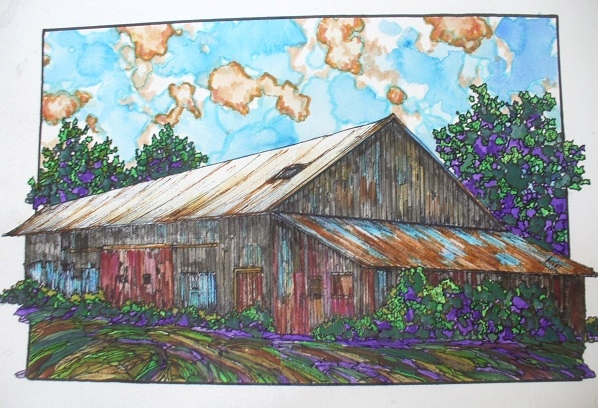
Everyone has a special memory of their childhood and looking back over the years this is perhaps one of the nicest. An only child I was taken to visit my father’s family in Stevensville every Sunday and share in picnics, family gatherings and outings with the odd assortment of relatives who lived in the area. Because it was a weekly event, I sometimes resented the routine of my parents, but now I wish I could have one day with the Fox family eating scrumptious food prepared by my grandmother and listening to their stories. One of the best remembrances was the flavor of my grandmother’s icing that donned every cake. Made from farm fresh cream it is a taste one never forgets. Picnics were held on the farm under a shady tree and I can still see the grouping of people laughing and carrying on.
My father was raised on House Road, Stevensville, by his grandparents, and it was not an easy time. They had little money and he was often left to take care of himself, which he did quite successfully. The old house had a barn, circa 1860, that the Fuch family built on arrival to the area. I did not appreciate my roots until it was too late to record the stories which is often a sad fact of our past.
Last year I had the barn painted by my dear friend John Robert Bradley and it is part of a legacy to be passed on to my children. Taken from a photograph, the likeness is uncanny and a tribute to the artist. I wish to share John’s work with you and to see the value of preserving these images in whatever way we can.
[Submitted by B, November 2014]
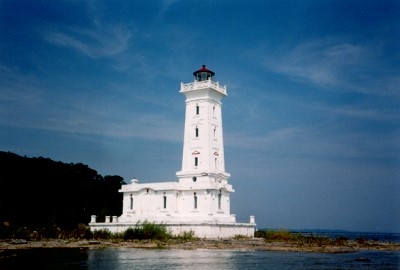
On my bucket list is a night sleeping in a lighthouse. The late Mr. Anonymous and I had spent many happy hours visiting these marvelous old structures, many now gone or in disrepair, and one of the finest we explored from a distance was Point Abino. One can not spend the night there, but tours are now arranged to see the lighthouse up close. I hope to take advantage of this opportunity next summer.
The lighthouse is 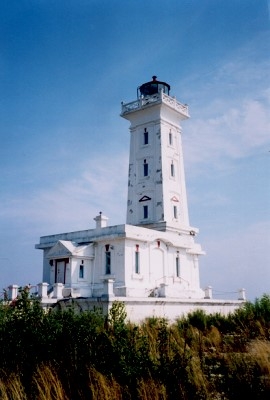 situated on a small plot of land owned by the Town of Fort Erie, but as Americans in gated communities own the surrounding landscape, it was impossible at the time to access this piece of history. We simply had to get closer, so we put the canoe in the water and paddled our way to Utopia. As long as we didn’t venture onto private land and stayed on Lake Erie, we were fine. Mr. Anonymous, bless his heart, could paddle at the speed of light if need be, but without a doubt it was a calm, pleasant journey. I have always thought of my canoe as a miniature yacht, so despite a few furrowed brows from the seamen on larger watercraft, we fit right in.
situated on a small plot of land owned by the Town of Fort Erie, but as Americans in gated communities own the surrounding landscape, it was impossible at the time to access this piece of history. We simply had to get closer, so we put the canoe in the water and paddled our way to Utopia. As long as we didn’t venture onto private land and stayed on Lake Erie, we were fine. Mr. Anonymous, bless his heart, could paddle at the speed of light if need be, but without a doubt it was a calm, pleasant journey. I have always thought of my canoe as a miniature yacht, so despite a few furrowed brows from the seamen on larger watercraft, we fit right in.
Some of these aged lighthouses have been recorded as being haunted, such as Gibraltar Point on Toronto Island, the oldest existing lighthouse on the Great Lakes. I have visited it several times, and thoroughly enjoy the mysterious story surrounding the famed lighthouse keeper, John Paul Radelmüller, who was murdered in 1815. Many a wondrous tale could all light keepers report of their lonely existence and challenging labor. They are truly to be respected.
 Subscribe..
Subscribe..
 At 90 years of age Frank Hesler still vividly recalls the years spent at Welland High.
At 90 years of age Frank Hesler still vividly recalls the years spent at Welland High.
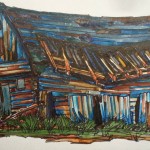
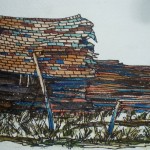
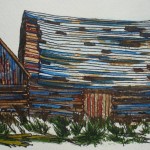
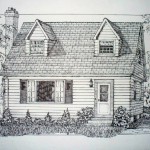


 situated on a small plot of land owned by the Town of Fort Erie, but as Americans in gated communities own the surrounding landscape, it was impossible at the time to access this piece of history. We simply had to get closer, so we put the canoe in the water and paddled our way to Utopia. As long as we didn’t venture onto private land and stayed on Lake Erie, we were fine. Mr. Anonymous, bless his heart, could paddle at the speed of light if need be, but without a doubt it was a calm, pleasant journey. I have always thought of my canoe as a miniature yacht, so despite a few furrowed brows from the seamen on larger watercraft, we fit right in.
situated on a small plot of land owned by the Town of Fort Erie, but as Americans in gated communities own the surrounding landscape, it was impossible at the time to access this piece of history. We simply had to get closer, so we put the canoe in the water and paddled our way to Utopia. As long as we didn’t venture onto private land and stayed on Lake Erie, we were fine. Mr. Anonymous, bless his heart, could paddle at the speed of light if need be, but without a doubt it was a calm, pleasant journey. I have always thought of my canoe as a miniature yacht, so despite a few furrowed brows from the seamen on larger watercraft, we fit right in.